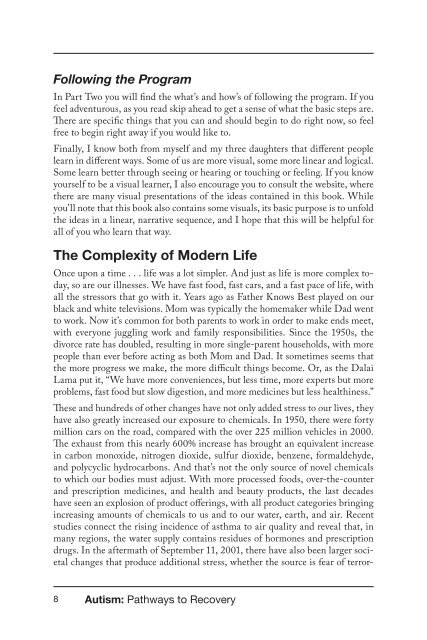3dT4E4Rnm
3dT4E4Rnm
3dT4E4Rnm
You also want an ePaper? Increase the reach of your titles
YUMPU automatically turns print PDFs into web optimized ePapers that Google loves.
Following the Program<br />
In Part Two you will find the what’s and how’s of following the program. If you<br />
feel adventurous, as you read skip ahead to get a sense of what the basic steps are.<br />
There are specific things that you can and should begin to do right now, so feel<br />
free to begin right away if you would like to.<br />
Finally, I know both from myself and my three daughters that different people<br />
learn in different ways. Some of us are more visual, some more linear and logical.<br />
Some learn better through seeing or hearing or touching or feeling. If you know<br />
yourself to be a visual learner, I also encourage you to consult the website, where<br />
there are many visual presentations of the ideas contained in this book. While<br />
you’ll note that this book also contains some visuals, its basic purpose is to unfold<br />
the ideas in a linear, narrative sequence, and I hope that this will be helpful for<br />
all of you who learn that way.<br />
The Complexity of Modern Life<br />
Once upon a time . . . life was a lot simpler. And just as life is more complex today,<br />
so are our illnesses. We have fast food, fast cars, and a fast pace of life, with<br />
all the stressors that go with it. Years ago as Father Knows Best played on our<br />
black and white televisions. Mom was typically the homemaker while Dad went<br />
to work. Now it’s common for both parents to work in order to make ends meet,<br />
with everyone juggling work and family responsibilities. Since the 1950s, the<br />
divorce rate has doubled, resulting in more single-parent households, with more<br />
people than ever before acting as both Mom and Dad. It sometimes seems that<br />
the more progress we make, the more difficult things become. Or, as the Dalai<br />
Lama put it, “We have more conveniences, but less time, more experts but more<br />
problems, fast food but slow digestion, and more medicines but less healthiness.”<br />
These and hundreds of other changes have not only added stress to our lives, they<br />
have also greatly increased our exposure to chemicals. In 1950, there were forty<br />
million cars on the road, compared with the over 225 million vehicles in 2000.<br />
The exhaust from this nearly 600% increase has brought an equivalent increase<br />
in carbon monoxide, nitrogen dioxide, sulfur dioxide, benzene, formaldehyde,<br />
and polycyclic hydrocarbons. And that’s not the only source of novel chemicals<br />
to which our bodies must adjust. With more processed foods, over-the-counter<br />
and prescription medicines, and health and beauty products, the last decades<br />
have seen an explosion of product offerings, with all product categories bringing<br />
increasing amounts of chemicals to us and to our water, earth, and air. Recent<br />
studies connect the rising incidence of asthma to air quality and reveal that, in<br />
many regions, the water supply contains residues of hormones and prescription<br />
drugs. In the aftermath of September 11, 2001, there have also been larger societal<br />
changes that produce additional stress, whether the source is fear of terror-<br />
8 Autism: Pathways to Recovery


